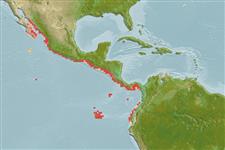Preferred temperature (Ref.
115969): 21.4 - 29, mean 27 (based on 86 cells).
Phylogenetic diversity index (Ref.
82804): PD
50 = 0.5312 [Uniqueness, from 0.5 = low to 2.0 = high].
Bayesian length-weight: a=0.00832 (0.00504 - 0.01373), b=3.02 (2.88 - 3.16), in cm Total Length, based on LWR estimates for this species & (Sub)family-body (Ref.
93245).
Trophic level (Ref.
69278): 2.9 ±0.28 se; based on food items.
устойчивость к внешним воздействиям (Ref.
120179): высокий, минимальное время удвоения популяции до 15 месяцев (K=0.22-0.5).
Prior r = 0.43, 95% CL = 0.28 - 0.64, Based on 2 full stock assessments.
Fishing Vulnerability (Ref.
59153): Low vulnerability (25 of 100).
Climate Vulnerability (Ref.
125649): Moderate vulnerability (37 of 100).
